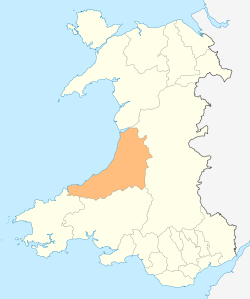Mwnt
| Mwnt | |
| Welsh: (Y) Mwnt | |
 Mwnt Church from the headland |
|
 Mwnt |
|
| OS grid reference | SN194520 |
|---|---|
| Principal area | Ceredigion |
| Ceremonial county | Dyfed |
| Country | Wales |
| Sovereign state | United Kingdom |
| Post town | CARDIGAN |
| Postcode district | SA43 |
| Dialling code | 01239 |
| Police | Dyfed-Powys |
| Fire | Mid and West Wales |
| Ambulance | Welsh |
| EU Parliament | Wales |
| UK Parliament | Ceredigion |
| Welsh Assembly | Ceredigion |
|
|
Coordinates: 52°08′13″N 4°38′20″W / 52.13684°N 4.63878°W
Mwnt is a very small community and ancient parish in south Ceredigion, Wales, on the West Wales coast about 4.5 miles (7.2 km) from Cardigan. It lies on the Ceredigion Coast Path.
It gets its name from the prominent steep conical hill (Foel y Mwnt), a landmark from much of Cardigan Bay, that rises above the beach to a height of 76m (249ft), and was formerly anglicised as Mount.[1]
The beach
Mwnt is known for its popular beach. In 2011 The Daily Mail placed Mwnt top of its list of "Europe's top ten loveliest hidden beaches".[2]
The beach has earned a Green Coast Award (an award similar to a Blue Flag beach Award but for rural beaches).[3] Swimming conditions are considered safe at Mwnt but there is no lifeguard service.[4]
The Irish Sea off Mwnt is rich in wildlife, being a regular summer home to dolphins, seals and porpoises.
Flemish invasion
Mwnt was the site of an unsuccessful invasion by Flemings in 1155. Its defeat was celebrated, at least in the eighteenth century, by a games meeting on the first Sunday in January known as "Sul Coch y Mwnt" (Red Sunday), commemorating the blood shed on that day. Within living memory human bones and skeletons have been exposed in the area. A nearby brook is called Nant y Fflymon (Flemings' Brook).[5]
Church of the Holy Cross
The Church of the Holy Cross (Welsh: Eglwys y Grog) is an example of a medieval sailor's chapel of ease. The site is said to have been used since the Age of the Saints, but the present building is probably 14th century. It has an example of a 12th or 13th century font made of Preseli stone. Mwnt was a civil parish in its own right for several centuries, but before the 17th century it was a detached chapelry of the parish of Llangoedmor. Since 1934, it has been part of the parish of Y Ferwig. The church is a Grade I listed building.[6]
The beach (but not the church) is owned by the National Trust, who exercise a conservation remit over both.
|
See also
References
- ↑ "GENUKI: Mount". Retrieved 6 April 2016.
- ↑ Daily Mail - Europe's secret beaches Retrieved 18 December 2011
- ↑ Visit Pembrokeshire Retrieved 18 December 2011
- ↑ Cardiganshire cast and Country - Mwnt beach Retrieved 18 December 2011
- ↑ "MWNT, SITE OF FLEMISH INVASION". Coflein. Royal Commission on the Ancient and Historical Monuments of Wales. Retrieved 23 September 2016.
- ↑ "Church of the Holy Cross, Mwnt, Y Ferwig". British Listed Buildings. Retrieved 23 August 2014.
External links
| Wikimedia Commons has media related to Mwnt. |





